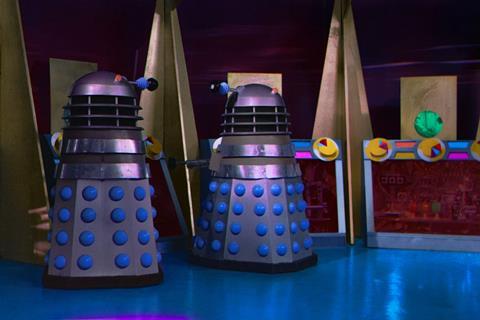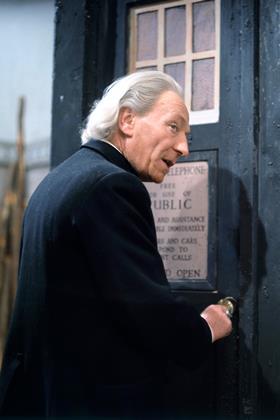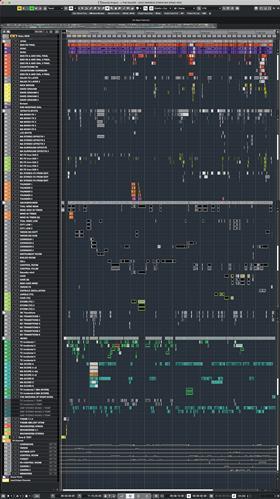As part of its celebrations for the 60th anniversary of Doctor Who, the BBC commissioned a feature-length version of one of the most important stories in the show’s history, in full colour with a Dolby Atmos soundtrack. Kevin Hilton talks to the sound designer and colourisation artists who worked on The Daleks in Colour.
Doctor Who is all about the past, the present and the future. For the past 60 years, the BBC science fiction series has followed the Doctor’s adventures through time and space, celebrating that milestone at the end of last year with three specials featuring one of the most popular recent Doctor and companion combinations - David Tennant and Catherine Tate - and also introducing the latest actor to take on the role, Ncuti Gatwa, ahead of his first full episode on Christmas Day.

The 60th-anniversary celebrations looked back to Doctor Who’s beginnings in 1963 with a feature-length, colourised version of the second serial to be broadcast, which is now available on Blu-ray Disc (BD) in Dolby Atmos immersive audio. The Daleks is famous for both introducing the fascistic mutants-in-a-can as enemies of the Doctor and cementing the popularity of the show with its young - and later cultish - audience.
Read more Adventures beyond stereo: perfecting the immersive audio mix
This made it the obvious choice to present in a new form for both long-time fans and newcomers not familiar with the classic period of the show or the first Doctor, played by William Hartnell. To ensure that the edit, colourisation and new sound and music were produced in sympathy with the original, returning Showrunner Russell T Davies and Executive Producer Phil Collinson selected professionals who were also either fans of Doctor Who or already had an association with the show.
Dream team
The colourisation team was led by Rich Tipple, who, when he received a call late in 2022 from someone claiming to be Phil Collinson’s assistant, initially thought it was a friend playing a joke. “I’m a huge Doctor Who fan and have been colourising clips as a hobby for several years,” he says. “I’m also a full-time director, producer and editor, so I’ve got a good understanding of the processes and software involved in video production. I did an Adobe After Effects training course in 2011 and started playing with masks to apply colour to footage. I immediately thought, ‘I could use this to colourise Doctor Who’ and I started a YouTube channel to show the results.”

Tipple explains that Collinson wanted fans involved because he knew they would treat the material “with the respect it deserves”, so he brought in follow enthusiasts Kieran Highman, Scott Burditt and Timothy K Brown. Following the brief, that this version should have vibrancy and colour to breathe new life into the original, Tipple and Highman worked on After Effects, while Burditt and Brown used Photoshop. “There’s no one process or piece of software you use to colourise something,” Tipple explains. “It’s about fitting the right approach to the right shot. It was a very collaborative way of working and we built a very strong bond over the course of the project.”
Reference and inspiration
Doctor Who was produced and transmitted in black and white for its first seven years, making the move to colour in 1970 at the start of the Third Doctor’s incarnation. Two very colourful feature films based on the first two Dalek TV serials - The Daleks and The Dalek Invasion of Earth (1964) - were produced by AARU Productions under the titles Dr Who and the Daleks (1965) and Daleks’ Invasion Earth 2150 AD (1966), starring Peter Cushing.
Read more Power of Color Symposium 2024: Flesh tones, shooting open gate, and AI in post
Tipple says these did provide some inspiration but that other influences also guided the colourisation work. “There were a few colour behind-the-scenes photos from the TV serial available to us, which were really interesting,” he explains. “We took the bits we liked and allowed ourselves a degree of creative licence on the bits we felt could handle it. An example of this is the scene in which Daleks cut through a door and blast an empty Dalek casing the Doctor and his companions had been using as part of an escape plan. I thought the red surround of the doors was lovely, as were the walls but decided to make the door bronze rather than silver and also use the same blue floor that was in the TARDIS interior, which really warmed everything up. Obviously, the Cushing movies were a gift. We’d have been mad to ignore them.”
Dolby Atmos
Doctor Who has always relied on music and sound effects as much as the sometimes clunky and budget-constrained special and visual effects to help create the worlds visited by the Doctor. Mark Ayres has had a long association with Doctor Who, both as a composer for some of the last serials of the classic era and in curating the archive of the BBC Radiophonic Workshop, which created electronic sounds and music for the series from 1963 to 1989. He has also worked on the remastered DVD and BD Doctor Who season collections, re-mixing at least one episode for each in 5.1 surround and, latterly, Dolby Atmos.

The original score for The Daleks was written by Tristram Cary, who was both an orchestral composer and an early exponent of electronic music. Ayres, who became friends with Cary during the 1990s, comments that an initial suggestion was to re-score the episode, along with replacing the original Dalek voices performed by voice artists Peter Hawkins and David Graham. “I fought against both of those ideas because my personal feeling was that if we were celebrating early Doctor Who we should also celebrate the performances and artistry that went into it,” he says. “That includes both the music and the Dalek voices by Peter and David, who created the role of the Daleks in much the same way William Hartnell created the role of the Doctor.”
This was agreed to, on the condition it could be made to work. To achieve this, Ayres suggested a new recording session with David Graham, who, at the age of 98, is still voice acting as Peppa Pig’s Grandpa although he is probably best remembered for playing Parker in Thunderbirds. “There were bits of dialogue that needed moving around and because we were trying to remix something for which we didn’t have the original elements, we needed to re-record some things,” Ayres explains. “The first Dalek line you hear is a new David Graham line. We also got in the current voice of the Daleks, Nick Briggs, as a special guest Dalek to fill in any gaps.”
Preservation and restoration
The videotape on which early Doctor Who was recorded was wiped or disposed of decades ago, with some episodes from the 60s still missing or lost forever. Like others that survived, The Daleks existed on a 16mm film print, with the original mono audio mix (dialogue, music and effects) as part of the optical track.
“Over the last 30 years I’ve made it my life’s work to preserve as much of this material - original music and sound effects - as I can,” Ayres comments. “For this one, we had all the original music tapes, which Tristram let me have in the 90s, and most of the original sound effects were in the Radiophonic Workshop archive. The main thing we didn’t have was production sound because in those days there was no post-production on the sound - or very little - so all we had was the original mono mix of the broadcast episode and the mono music and effects.”
Read more HS-Art Digital to premiere Diamant-Film Coloriser at IBC
This, Ayres continues, meant that both the frequency and dynamic responses of the available audio tracks were extremely restricted. “The first thing I did was to go through it all and try to remove as much music and effects as I could from the original mix so I could add them back in,” he explains. “There was a lot of dialogue clean-up and separating elements out, using software including Izotope RX and Steinberg SpectraLayers.”

All track-laying and remixing was carried out by Ayres in his personal studio. “I re-built the mix in Atmos, which is insane,” he laughs. “I have a very complicated set-up, mixing in Nuendo [digital audio workstation (DAW)] on a Mac Studio with an internal Atmos renderer and all the sub-mixes working at once. I could switch between them and at any point monitor Atmos or the 5.1 and stereo fold-downs and even the mono fold-down, which is important to check for any phase issues. I also had a button for playing back the original track, with the edit track and temporary mix prepared by the editor, Benjamin Cook, plus his original music and dialogue edits. I was constantly comparing to make sure I was not too far away from the original and that everything worked on the fold-downs.”
Ayres also composed some additional music to expand Tristram Cary’s score, which was created using soft-synths, samples and a vintage VCS3 synthesiser. These tracks were recorded and mixed in stereo using a Logic DAW and then upmixed into Dolby Atmos using the Penteo Surround plug-in.
“The original music and effects, all the background sounds and Tristram Cary’s music were all enhanced into 7.1.4, atmospherically rather than discretely,” Ayres comments. “So I had an atmospheric mix, at the heart of which was the mono mix, and the effects could go almost anywhere. When the Doctor and his companions are in the jungle at the start of the story, one companion, Ian, comments that there’s a wind blowing. So I put some light wind noise and the sound of dry leaves [rustling] right up high to give the impression of wind above. You can do that really subtly in Atmos. There is also a storm, with thunder and lightning overhead, and I put the climatic Dalek bomb countdown in the height loudspeakers to give the sense of something looming over us. Height is an exciting extra dimension to play with but generally, most of the surround effects are quite subtle.”
The whole project took an estimated 12 months, with the colourisation process accounting for around 10 and a half months. The results can be judged on both the recently released Blu-ray, with its Dolby Atmos soundtrack, and also BBC iPlayer (in stereo). After The Daleks in Colour, Whovians can now start betting on which classic serial will be the next to be colourised, with an announcement due towards the end of the year.
























No comments yet